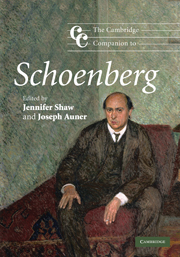Book contents
- Frontmatter
- 1 Introduction
- Part I Schoenberg's early years
- Part II Schoenberg, modernism, and modernity
- 6 Interpreting Erwartung: collaborative process and early reception
- 7 The rise and fall of radical athematicism
- 8 Schoenberg, modernism, and metaphysics
- 9 Pierrot lunaire: persona, voice, and the fabric of allusion
- Part III Schoenberg between the World Wars
- Part IV Schoenberg's American years
- Notes
- Select bibliography
- Index
7 - The rise and fall of radical athematicism
from Part II - Schoenberg, modernism, and modernity
Published online by Cambridge University Press: 28 September 2011
- Frontmatter
- 1 Introduction
- Part I Schoenberg's early years
- Part II Schoenberg, modernism, and modernity
- 6 Interpreting Erwartung: collaborative process and early reception
- 7 The rise and fall of radical athematicism
- 8 Schoenberg, modernism, and metaphysics
- 9 Pierrot lunaire: persona, voice, and the fabric of allusion
- Part III Schoenberg between the World Wars
- Part IV Schoenberg's American years
- Notes
- Select bibliography
- Index
Summary
In a famous letter from early August 1909, Arnold Schoenberg wrote to Ferruccio Busoni, describing his credo of composition. For our purposes, the key passage is:
I strive for: complete liberation from all forms from all symbols of cohesion and of logic.
Thus: away with “motivic working out.”
Away with harmony as cement or bricks of a building.
Harmony is expression and nothing else.
Then: Away with Pathos!
Away with protracted ten-ton scores, from erected or constructed towers, rocks and other massive claptrap.
My music must be brief.
Concise! In two notes: not built, but “expressed.”
Schoenberg's rapturous and poetic description of his compositional philosophy is a remarkably precise portrayal of his compositions, beginning with the third movement of the Three Pieces for Piano, Op. 11 (completed August 7, 1909). Beginning in August 1909, there is indeed “liberation from all forms” and from “symbols of cohesion and logic.” There is no “motivic working out,” no “harmony as cement or bricks of a building,” no “ten-ton scores,” no “erected or constructed towers,” and Schoenberg's works have become significantly shorter than before (and in the Three Pieces for Chamber Orchestra of 1910 would become shorter still).
At the same time, essential aspects of the compositional philosophy described in this letter are completely incompatible with the compositions that Schoenberg had written only days earlier. If one were pressed to name the single most prominent compositional feature of the compositions that immediately preceded the letter to Busoni (the first two movements of Op. 11 and Nos. 1–4 of the Five Orchestral Pieces,Op. 16), it would have to be “motivic working out,” arguably some of the most careful, pervasive, and thorough motivic working out there ever was.
- Type
- Chapter
- Information
- The Cambridge Companion to Schoenberg , pp. 94 - 107Publisher: Cambridge University PressPrint publication year: 2010
- 1
- Cited by

